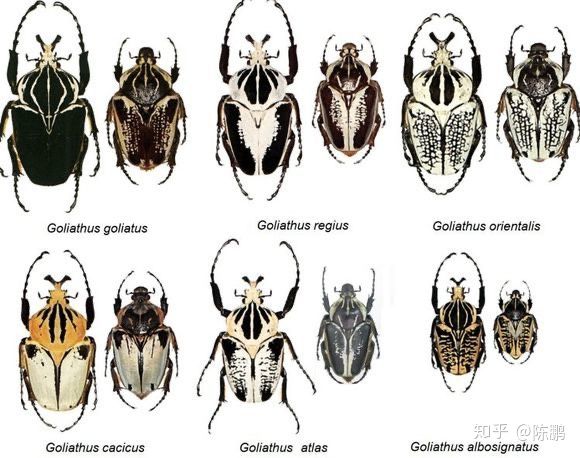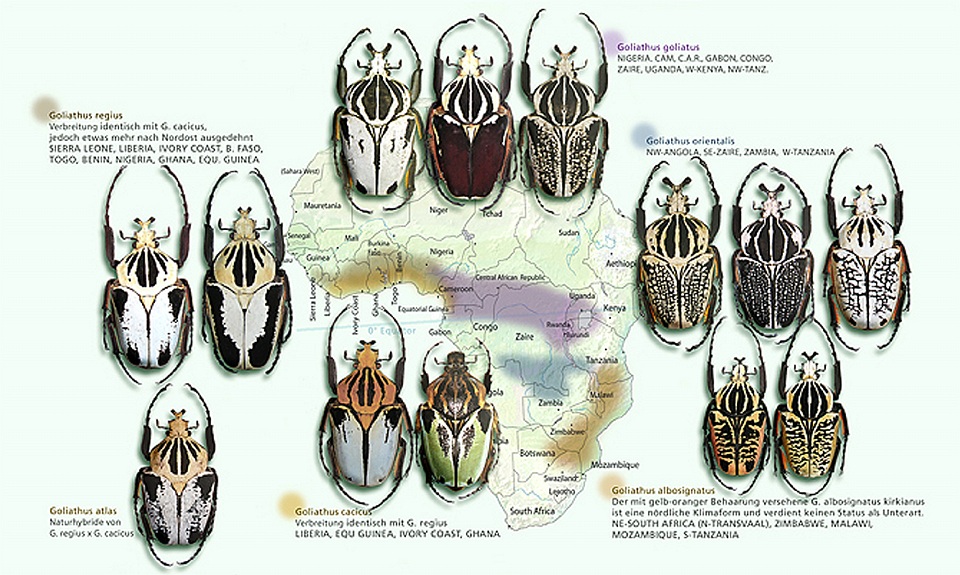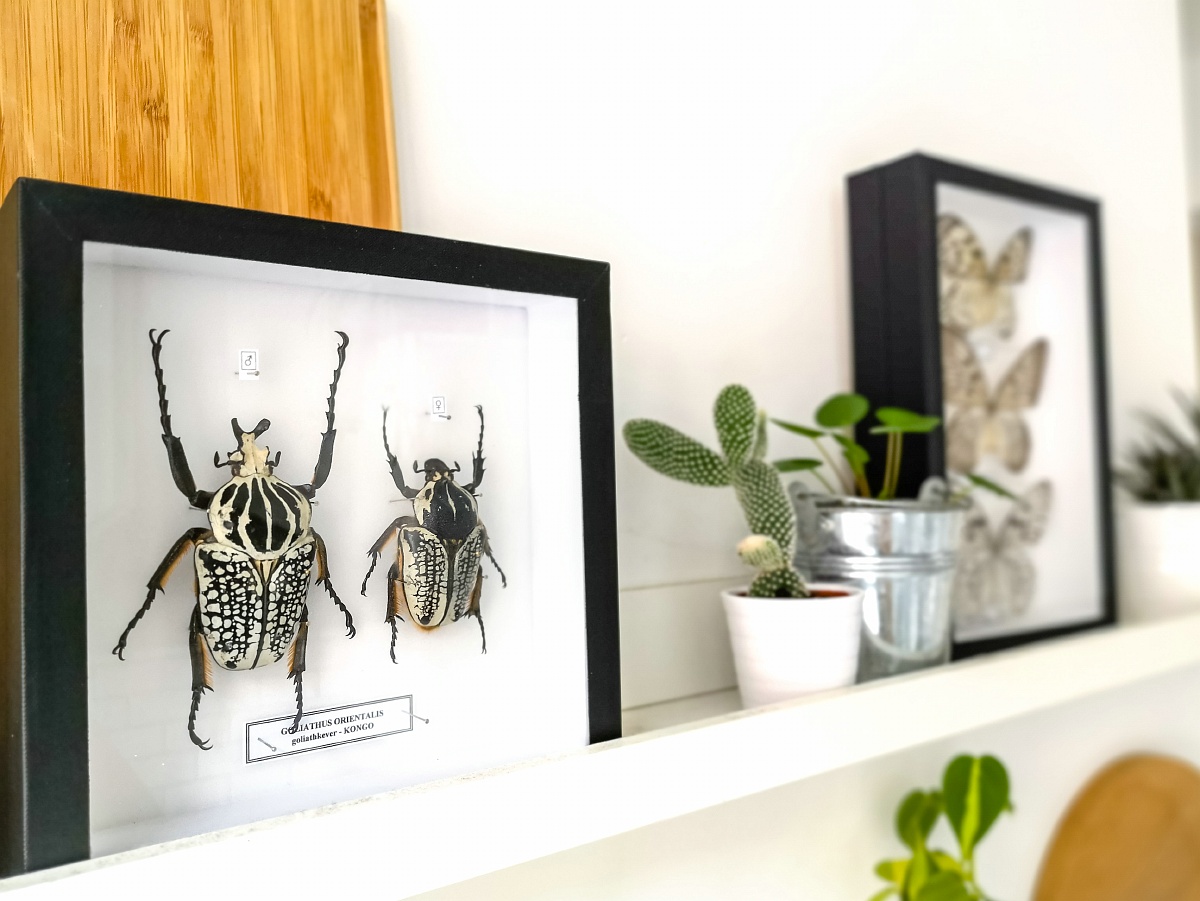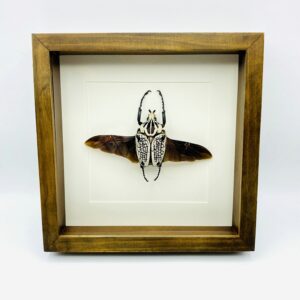1. Goliathus cacicus
- Latin name: Goliathus cacicus
- Where they are found: Nigeria, Liberia, Ghana, Guinea, Sierra Leone, Ivory Coast
- Size: 50 – 100 millimeters (males), 40 – 70 millimeters (females)
- Unique feature: Orange thorax, pure white back
- Diet: Fruit, tree sap
What’s unique about the Goliathus cacicus Goliath beetle?
You’ll be able to spot a Goliathus cacicus faster than any other Goliath beetle. Not only do they come in rare colors, but they’re rare, period.
They’re much harder to find on the market than any other Goliath beetle sub-species. If you see a Goliathus cacicus, snatch it up while you can!
What does the Goliathus cacicus Goliath beetle look like?
Goliathus cacicus are known for their bright colors. While other Goliath beetles are limited to shades of black and white, Goliathus cacicus come in yellow, amber and orange. They also have pure white backs instead of the usual mottles or “streaks” of black.
2. Goliathus albosignatus
- Latin name: Goliathus albosignatus
- Where they are found: Mozambique, South Africa, Tanzania, Zimbabwe
- Size: 45 – 70 millimeters (males), 40 – 50 millimeters (females)
- Unique feature: Skeleton coloring
- Diet: Fruit, tree sap
What’s unique about the Goliathus albosignatus Goliath beetle?
Goliathus albosignatus have black-and-white bodies with unusual patterns on their backs and abdomens. Some people call them bones; other people call them starbursts or streaks.
What does the Goliathus albosignatus Goliath beetle look like?
Goliathus albosignatus know how to make an impression. They have black markings on their white bodies that look a lot like the bones of a skeleton, and they’re one of the smaller species of Goliath beetles. They’re easy to pick out of a crowd.
3. Royal Goliath beetle
- Latin name: Goliathus regius
- Where they are found: Ghana, Nigeria, Guinea, Burkina Faso, Ivory Coast, Sierra Leone
- Size: 50 – 110 millimeters (males)
- Unique feature: Largest of the species
- Diet: Fruit, bark, tree sap, protein
What’s unique about the Royal Goliath beetle?
The Royal Goliath beetle is the largest of the species. It can reach 3 – 4 inches in length, and that’s almost the size of a human hand!
What does the Royal Goliath beetle look like?
The Royal Goliath beetle looks quite similar to the Goliathus albosignatus beetle with its black-and-white skeleton markings.
However, it can be distinguished from the other by the two black “bands” on either side of its back. If you look closely, it usually has wider bands on its thorax as well.
4. Goliathus orientalis
- Latin name: Goliathus orientalis
- Where they are found: Congo, Tanzania
- Size: 50 – 90 millimeters (males), 50 – 65 millimeters (females)
- Unique feature: White bodies
- Diet: Fruit, tree sap
What’s unique about the Goliathus orientalis Goliath beetle?
Goliathus orientalis have a limited range compared to other Goliath beetles, and that makes them harder to catch.
They’re also one of the larger sub-species. Some of their females can be bigger than the fully-grown males of other breeds!
What does the Goliathus orientalis Goliath beetle look like?
Goliathus orientalis have a shorter, stockier appearance than their cousins. Their bodies are primarily white with black scribbles along their backs. Their wings are black or blackish.
5. Goliathus goliatus
- Latin name: Goliathus goliatus
- Where they are found: Congo, Cameroon, Kenya, Gabon, Nigeria, Tanzania, Uganda, Central African Republic
- Size: 50 – 100 millimeters (males), 50 – 80 millimeters (females)
- Unique feature: Red backs
- Diet: Fruit, tree sap, dead leaves
What’s unique about the Goliathus goliatus Goliath beetle?
Goliathus goliatus are widespread across Africa. They’re the only Goliath beetle with a reddish coloring, which makes them easy to spot in the wild, and they’re popular with collectors and breeders everywhere.
What does the Goliathus goliatus Goliath beetle look like?
With their red backs, Goliathus goliatus are one of the most distinctive breeds of Goliath beetle.
They have the usual stripes on their upper halves, but their bottom halves are solidly colored in crimson.
6. Goliathus atlas
- Latin name: Goliathus atlas
- Where they are found: Burkina Faso and Ivory Coast
- Size: 50 – 110 millimeters (males)
- Unique feature: Largest of the species
- Diet: Fruit, bark, tree sap, protein
What’s unique about the Goliathus atlas?
A very rare form of Goliath beetle – only a few specimens have been collected. It is strongly believed that G. atlas is not actually a true species, but a hybrid that results from interbreeding between G. regius and G. cacicus.
What does the Royal Goliath beetle look like?
The elytra are primarily white with some black horizontal banding which is often reduced to a number of irregularly shaped spots.

30 Goliath Beetle Facts
1. What does the Goliath beetle look like?
While they share a general shape and size, Goliath beetles can be distinguished from one another with their colors, markings, and patterns. Here’s a brief breakdown:
- Goliathus cacicus: Orange or yellow bodies, pure white backs
- Goliathus albosignatus: Thin, black-and-white skeleton lines
- Goliathus regius: Thin, black-and-white skeleton lines with black bands on either side of the body
- Goliathus orientalis: White bodies with black scribbles on their backs
- Goliathus goliatus: Red backs
- Goliathus atlas: Primarily white with some black horizontal banding which is often reduced to a number of irregularly shaped spots.
Aside from these superficial differences, however, you’ll find that most Goliath beetles look alike:
- They have large, powerful bodies with three sets of legs that end in claws.
- Their flying wings are tucked underneath a harder, reinforced set of wings that act as a protective barrier.
- Males have “horns” on their heads that they use for battling other males.
- Females have wedge-shaped heads for burrowing underground to lay their eggs.
2. How big is a Goliath beetle?
Goliath beetles are considered one of the largest insects in the world. Others might be longer, taller or heavier, but in terms of relative mass for their body size, Goliath beetles reign supreme.
Goliathus albosignatus is the smallest sub-species while Goliathus regius is the biggest.
Here’s a complete chart:
- Goliathus cacicus: 50 – 100 millimeters (males), 40 – 70 millimeters (females)
- Goliathus albosignatus: 45 – 70 millimeters (males), 40 – 50 millimeters (females)
- Goliathus regius: 50 – 110 millimeters (males)
- Goliathus orientalis: 50 – 90 millimeters (males), 50 – 65 millimeters (females)
- Goliathus goliatus: 50 – 100 millimeters (males), 50 – 80 millimeters (females)
- Goliathus altas: (hybrid of regius and cacicus) 50 – 100 millimeters (males), 40 – 70 millimeters (females)
3. How much does a Goliath beetle weigh?
Goliath beetles usually weigh around 50 – 60 grams. Their larvae can reach between 80 – 100 grams, but since they shrink during their metamorphosis, adults only weigh about half as much as their children.
4. How do male Goliath beetles differ from females?
Goliath beetles experience sexual dimorphism; the males of the species are always bigger than the females.
Males are also in possession of two-pronged “horns” on their heads that they use to battle other males for feeding and mating rights.
Females don’t have these horns, but their heads tend to be more wedge-shaped to help them burrow underground for reproductive purposes.
5. Can Goliath beetles climb?
Yes. Goliath beetles have forked feet that allow them to cling to trees, branches, and vines, so they’re agile climbers.
However, you won’t find them on many leaves. They’re too heavy to perch on something that flimsy!
6. Can Goliath beetles fly?
Yes. Goliath beetles are capable flyers, and they’re actually born with two sets of wings to help them get around:
- The first set is called the elytra, and they’re made of a hard, protective material that acts as a shield for the second set.
- The second set of wings is large and membranous, and they’re pretty fragile, so they’re kept folded under the elytra when not in use.
Double-layer wings aren’t unique to Goliath beetles. In fact, it’s a characteristic of just about every beetle species.
It simply looks more dramatic when Goliath beetles spread open their secret wings since they’re one of the largest beetle species in the world.
7. How did the Goliath beetle get its name?
As you might have guessed, the Goliath beetle has Biblical roots. It’s named after the giant from the story of David and Goliath.
8. What is the Goliath beetles Latin name?
Each species of Goliath beetle has its own scientific name:
- Goliathus cacicus
- Goliathus albosignatus
- Goliathus regius
- Goliathus orientalis
- Goliathus goliatus
- Goliathus atlas
The origins of these names aren’t known, but they’re pretty easy to guess. For example, Goliathus regius is the largest sub-species, so it’s named “regal.”
Goliathus orientalis is found in eastern Africa as opposed to western Africa, so it’s called “oriental.”
9. Are Goliath beetles friendly or aggressive?
Goliath beetles can be quite aggressive. In the wild, males fight each other for food and mates by locking their horns in a kind of dominance battle. And they can get extremely territorial if another beetle starts trespassing in their domain.
In captivity, males have been known to chase females around their tanks when they want to breed. There have even been reports of cannibalism among Goliath beetle larvae.
It should be noted, however, that this behavior is limited to other beetles. Goliaths aren’t dangerous to humans outside of the occasional pinch from their mandibles.
10. What’s the life cycle of a Goliath beetle?
Like all beetles, Goliath beetles go through four stages of life:
- Egg
- Larva
- Pupa
- Adult
The female will lay eggs underground or in a pile of wet, mushy leaves. The larvae will emerge from the eggs and do nothing but eat for months and months while they grow into their famously large size.
After four months or so, the larvae will be as big as they’re going to get, and they’ll dig themselves deeper into the soil and create a hard, cocoon-like shell that protects them as they enter the pupal phase.
They’ll remain completely motionless as their bodies shrink and their tissues restructure. Their exoskeletons will form. Their wings will grow.
The rainy season marks the end of their metamorphosis. The rain will seep into the earth and soften the hard shells of their cocoons, and they’ll break out and begin their lives as fully-formed adult beetles.
At this point, they’ll reproduce and start the cycle all over again with a new generation.
11. Do Goliath beetles bite?
Goliath beetles don’t have teeth, but their mandibles can deliver a sharp pinch that’s reminiscent of a bite. These bites can draw blood but aren’t serious.
12. How strong are Goliath beetles?
Are you ready for this? Goliath beetles can lift up to 850 times their own body weight! This is all relative to their size, of course; you won’t see a Goliath beetle bench-pressing a car.
But they’re extremely tough creatures with claws, horns, and mandibles, and they hide all of their vulnerable parts beneath hard wings and thick exoskeletons.
If you were a bug, you wouldn’t want to mess with the Goliath beetle.
13. How long do Goliath beetles live?
Like most beetle species, Goliath beetles have short lives. They die around 3 – 6 months after reaching their adult form.
It should be noted, however, that they can spend just as long as that in their larvae and pupal stage, so their entire lifespan is closer to 6 – 12 months.
14. What eats a Goliath beetle? Predators and Threats
The Goliath beetle doesn’t have any systematic predators, but they’re vulnerable to anything that eats beetles in general, including frogs, birds, lizards, rodents and other mammals.
The larval stage is the most dangerous for them. Since they’re essentially worms in that form, they don’t have any of their natural defenses against predation.
15. How do Goliath beetles protect themselves?
Goliath beetles are firmly on the “flight” side of the fight-or-flight spectrum. They’ll tussle with each other, but they don’t stand a chance against things like monkeys and falcons, and they know it.
Their best defense is to avoid getting caught in the first place. If possible, they’ll climb or fly away from danger, but they try not to put themselves in those situations at all.
They prefer to hide in leaves, logs, compost and other forms of vegetation until the predators pass.
16. Is the Goliath beetle endangered?
The Goliath beetle hasn’t been evaluated by any conservation groups yet. It doesn’t even have a listing with the ICUN.
However, it’s unlikely to be endangered; it has a wide habitat range with several different sub-species thriving in different parts of Africa. It’s doing just fine.
17. What do Goliath beetles eat?
Goliath beetles like sugar, so their primary diet is tree sap and ripe fruit. They’ll munch on things like dung, bark and dead leaves if food is scarce, but this isn’t common.
They don’t prey on other insects except in cases of larvae cannibalism.
18. Can Goliath beetles eat kibble?
It’s strange but true! Goliath beetles can eat pet food when they’re in the larvae stage.
They need a diet that’s high in protein, so breeders can bury kibble in their soil to supplement the organic matter that they’d usually get from compost. The larvae will gobble it right up.
19. How do Goliath beetles eat?
Since they don’t have teeth, you might be wondering how Goliath beetles eat. The answer lies in their mouth parts.
Not only do they have sharp, claw-like mandibles that can rip into fruit and tree bark, but they also have fuzzy areas in their mouths that look like tiny paintbrushes.
These are comprised of hundreds of tiny bristles that act like mops to soak up the juices of their food.
20. Are Goliath beetles loud?
Goliath beetles can get pretty loud. Their wings beat furiously fast, so they can sound like anything from a helicopter to a jackhammer when they really get going.
They’re also capable of producing a humming or buzzing sort of sound that’s pretty audible.
The good news is that their noises will be easy to hear when you’re trying to spot a Goliath beetle on a nature walk.
The bad news is that they might keep you awake at night if you’ve purchased one as a pet!
21. Do Goliath beetles have any significance in African culture?
Goliath beetles have been recognized and appreciated by the people of Africa for centuries. Their beauty makes them a cultural touchstone, and their rarity makes them a valuable export. They’ve even been featured on stamps from a half-dozen countries.
22. What’s the breeding season of Goliath beetles?
There’s no particular breeding season for Goliath beetles. They’re ready to reproduce as soon as they emerge from their cocoons.
They live such short lives that they can’t really afford to wait around for ideal mating conditions.
23. Where does the female Goliath beetle lay her eggs?
Do you remember the difference between male and female Goliath beetles? Males have a horn for dominance battles, but females have a wedge-shaped head for burrowing into soil and compost.
This is where she’ll lay her eggs. She’ll look for trees, logs, rotten branches and anywhere else that’s dark and moist for good larvae development.
24. How many eggs does the Goliath beetle lay?
A Goliath mom will lay about 30 – 50 eggs in her lifetime in several different batches. The eggs will take a couple of weeks to hatch, and she won’t be interested in mating again until they do.
25. What do Goliath beetle grubs look like?
Goliath beetle grubs are massive things that look like a cross between a worm and a caterpillar.
They’re usually white or cream-colored, and they have fat, wrinkled bodies without eyes. They don’t actually need to see. They live completely underground.
26. How big are Goliath beetle grubs?
Goliath beetles are absolutely huge in the larval stage. They’re even bigger than their adult counterparts!
They can grow up to 250 millimetres (or 9.8 inches) in length, and their weight can exceed 100 grams (3.5 ounces). They’ll only shrink as they enter the pupal phase.
27. Can you eat Goliath beetle grubs?
It isn’t uncommon for rural African communities to make a meal out of both beetles and beetle grubs. You can find them everywhere from street stalls to exotic restaurants.
Some are fried to a crisp; others are baked, broiled or roasted with side dishes. You can even eat them raw and wiggling if you’re especially brave.
28. Do Goliath beetle grubs eat each other?
Yes. No one knows if this happens in the wild or if it’s just a side effect of raising larvae too close together in captivity, but Goliath beetle grubs have been known to cannibalize each other.
They’ll munch on a sibling’s legs, or they’ll completely consume them. Breeders have left two grubs in a tank only to return and find one grub suspiciously missing while the other is suspiciously fat.
29. Where does the Goliath beetle live?
The Goliath beetle is native to Africa. Most sub-species are found in the west, but there are some scattered to the east and south as well. They only region that they don’t inhabit is northern Africa.
Here’s a list of their most common countries:
- Goliathus cacicus: Nigeria, Liberia, Ghana, Guinea, Sierra Leone, Ivory Coast
- Goliathus albosignatus: Mozambique, South Africa, Tanzania, Zimbabwe
- Goliathus regius: Ghana, Nigeria, Guinea, Burkina Faso, Ivory Coast, Sierra Leone
- Goliathus orientalis: Congo, Tanzania
- Goliathus goliatus: Congo, Cameroon, Kenya, Gabon, Nigeria, Tanzania, Uganda, Central African Republic
- Goliathus atlas: Burkina Faso and Ivory Coast

30. What is the habitat of the Goliath beetle?
Goliath beetles live in tropical forests. They like trees, leaves, rain, humidity, wet soil, and rotting wood.
They aren’t your typical “African savanna” animals; in fact, they’ll perish if conditions are too hot or too dry. They need dark, moist places where they can lay their eggs and cocoon themselves as larvae.



